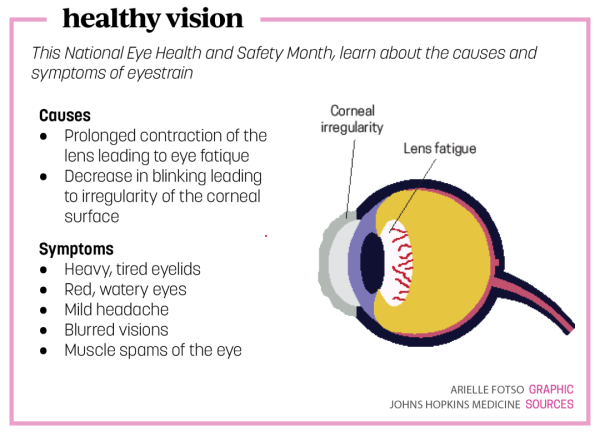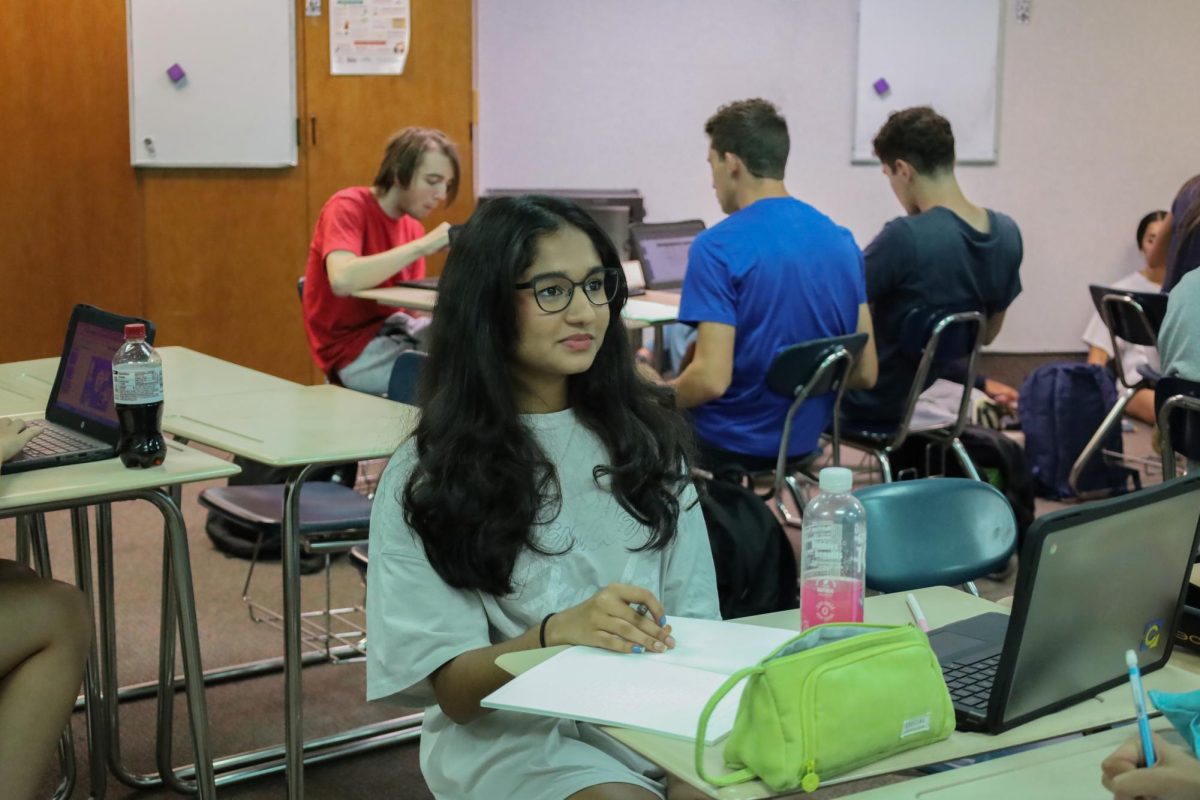For junior Kate Proctor, the majority of her day is spent online.
“As a student, I’m on my laptop all day in school to do assignments, then after school I have to spend several hours staring at my computer doing homework or reading,” Proctor said. “And then there’s the time I spend on my phone, using social media.”
Proctor’s said her reliance on her devices has prompted multiple concerns regarding her eye health.
“I’ve dealt with eye fatigue, headaches and migraines,” Proctor said.
Proctor is not alone. According to the Vision Council, almost two out of every three Americans report experiencing symptoms of digital eye strain. Digital eye strain is characterized by eye pain or eye fatigue, headaches, dry eye and blurred vision, as per the National Center for Health Research. With Children’s Eye Health and Safety month in August, students are reminded of the dangers blue light exposure pose on vision.
Junior Manvi Musnuru said she also struggles with eye pain following hours of studying.
“Recently, I’ve noticed that by the end of the day, my eyes get blurry and my head really hurts,” Musunuru said.
Musunuru said every day after school she spends a few hours doing her homework and studying, primarily using her electronic devices.
“I spend probably two hours after school every day studying, so I’m on my computer all day during school and after school,” Musunuru said. “It’s not great.”

Proctor shared this sentiment and said she feels pressured to study long hours.
“Since my classes are more difficult this year, I’ve had to study a lot more, which means there’s a lot of late nights where I’m up staring at my computer screen,” Proctor said.
According to the American Academy of Child and Adolescent Psychiatry, teenagers should only use devices for no more than two hours a day. However, high school students far exceed this number, as Common Sense Media reported in 2021 that the average teenager has a total screen time of more than eight hours per day.
Some of that can be attributed to changes in classes. For example, Musunuru said that she has seen an increase in digital homework assignments over the past couple of years.
“Since 2020, pretty much everything we do in class became accessed on Canvas,” Musunuru said. “Even most textbooks can be only accessed digitally.”
However, Musunuru said she prefers to use physical textbooks and notebooks over digital ones.
“I try to use a physical textbook whenever I can, and always take notes by hand,” Musunuru said.
Nicholas Garn, optometrist and co-owner of Zionsville Eyecare, said despite the ease of using a computer to read and take notes, there are advantages to using physical books and taking notes by hand.
“Recently, there has been more research done that shows tactical note taking with a pen and paper is more helpful than screens,” Garn said. “There’s a better brain-memory component with how we process information through our eyes that can actually put regular devices at a disadvantage while studying.”
Although further research is necessary, Garn said blue light exposure not only leads to short-term complications like eye strain, but has the potential of causing serious health consequences.
“One of the biggest things we’ve seen shifting in the last 10 to 15 years in students is actually dry eye,” Garn said. “When we are using devices, our blink rate actually drops down to 12 to 15 seconds, when outside of a device we normally blink every two to three seconds. We’ve seen more development of dry eye disease than we ever have before.”

Garn said a helpful tool for preventing dry eye is a pair of blue light glasses.
“Blue light glasses work by using a yellow filter which is supposed to negate the effect of the blue light,” Garn said. “They don’t fix everything but we have noticed that they help users blink more often, which prevents eye dryness.”
Additionally, Garn said in the past decade there has been a noticeable correlation between screen exposure and the development of myopia, or nearsightedness.
Proctor said she has made efforts to incorporate more non-screen activities into her daily routine.
“Instead of being on my computer I have found many other hobbies,” Proctor said. “I’ve picked up reading, doing puzzles and games among other things which are a nice break from my computer and phone.”
Musunuru said she often stops studying when she begins to develop symptoms of eye strain.
“I usually study for a while until my eyes start to hurt,” Musunuru said. “Then I will take a break and do something else for a bit.”
Similarly, Garn said his biggest recommendation for preventing digital eye strain is taking time to look away from screens during studying.
“Taking more breaks, even just two to three minutes of looking away from the screen, tends to be helpful—just getting up, walking around and maybe getting a drink of water before getting back to it,” Garn said. “The 20-20-20 rule is a general recommendation: Every 20 minutes, spend 20 seconds looking 20 feet away.”

































![AI in films like "The Brutalist" is convenient, but shouldn’t take priority [opinion]](https://hilite.org/wp-content/uploads/2025/02/catherine-cover-1200x471.jpg)









































![Review: “The Immortal Soul Salvage Yard:” A criminally underrated poetry collection [MUSE]](https://hilite.org/wp-content/uploads/2025/03/71cju6TvqmL._AC_UF10001000_QL80_.jpg)
![Review: "Dog Man" is Unapologetically Chaotic [MUSE]](https://hilite.org/wp-content/uploads/2025/03/dogman-1200x700.jpg)
![Review: "Ne Zha 2": The WeChat family reunion I didn’t know I needed [MUSE]](https://hilite.org/wp-content/uploads/2025/03/unnamed-4.png)
![Review in Print: Maripaz Villar brings a delightfully unique style to the world of WEBTOON [MUSE]](https://hilite.org/wp-content/uploads/2023/12/maripazcover-1200x960.jpg)
![Review: “The Sword of Kaigen” is a masterpiece [MUSE]](https://hilite.org/wp-content/uploads/2023/11/Screenshot-2023-11-26-201051.png)
![Review: Gateron Oil Kings, great linear switches, okay price [MUSE]](https://hilite.org/wp-content/uploads/2023/11/Screenshot-2023-11-26-200553.png)
![Review: “A Haunting in Venice” is a significant improvement from other Agatha Christie adaptations [MUSE]](https://hilite.org/wp-content/uploads/2023/11/e7ee2938a6d422669771bce6d8088521.jpg)
![Review: A Thanksgiving story from elementary school, still just as interesting [MUSE]](https://hilite.org/wp-content/uploads/2023/11/Screenshot-2023-11-26-195514-987x1200.png)
![Review: "When I Fly Towards You", cute, uplifting youth drama [MUSE]](https://hilite.org/wp-content/uploads/2023/09/When-I-Fly-Towards-You-Chinese-drama.png)
![Postcards from Muse: Hawaii Travel Diary [MUSE]](https://hilite.org/wp-content/uploads/2023/09/My-project-1-1200x1200.jpg)
![Review: "Ladybug & Cat Noir: The Movie," departure from original show [MUSE]](https://hilite.org/wp-content/uploads/2023/09/Ladybug__Cat_Noir_-_The_Movie_poster.jpg)
![Review in Print: "Hidden Love" is the cute, uplifting drama everyone needs [MUSE]](https://hilite.org/wp-content/uploads/2023/09/hiddenlovecover-e1693597208225-1030x1200.png)
![Review in Print: "Heartstopper" is the heartwarming queer romance we all need [MUSE]](https://hilite.org/wp-content/uploads/2023/08/museheartstoppercover-1200x654.png)




